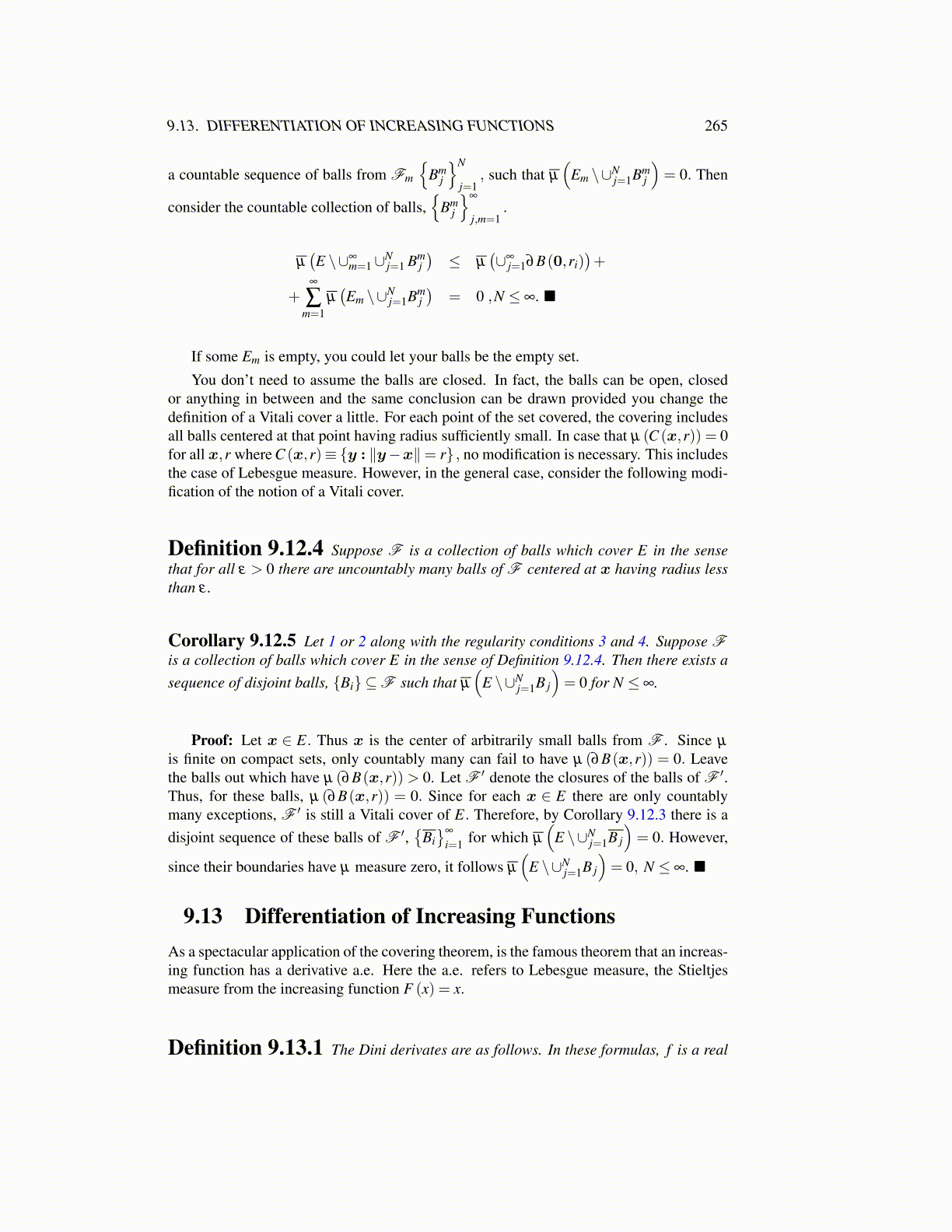
9.13. DIFFERENTIATION OF INCREASING FUNCTIONS 265
a countable sequence of balls from Fm
{Bm
j
}N
j=1, such that µ
(Em \∪N
j=1Bmj
)= 0. Then
consider the countable collection of balls,{
Bmj
}∞
j,m=1.
µ(E \∪∞
m=1∪Nj=1 Bm
j)≤ µ
(∪∞
j=1∂B(0,ri))+
+∞
∑m=1
µ(Em \∪N
j=1Bmj)
= 0 ,N ≤ ∞. ■
If some Em is empty, you could let your balls be the empty set.
You don’t need to assume the balls are closed. In fact, the balls can be open, closedor anything in between and the same conclusion can be drawn provided you change thedefinition of a Vitali cover a little. For each point of the set covered, the covering includesall balls centered at that point having radius sufficiently small. In case that µ (C (x,r)) = 0for all x,r where C (x,r)≡ {y : ∥y−x∥= r} , no modification is necessary. This includesthe case of Lebesgue measure. However, in the general case, consider the following modi-fication of the notion of a Vitali cover.
Definition 9.12.4 Suppose F is a collection of balls which cover E in the sensethat for all ε > 0 there are uncountably many balls of F centered at x having radius lessthan ε .
Corollary 9.12.5 Let 1 or 2 along with the regularity conditions 3 and 4. Suppose Fis a collection of balls which cover E in the sense of Definition 9.12.4. Then there exists asequence of disjoint balls, {Bi} ⊆F such that µ
(E \∪N
j=1B j
)= 0 for N ≤ ∞.
Proof: Let x ∈ E. Thus x is the center of arbitrarily small balls from F . Since µ
is finite on compact sets, only countably many can fail to have µ (∂B(x,r)) = 0. Leavethe balls out which have µ (∂B(x,r)) > 0. Let F ′ denote the closures of the balls of F ′.Thus, for these balls, µ (∂B(x,r)) = 0. Since for each x ∈ E there are only countablymany exceptions, F ′ is still a Vitali cover of E. Therefore, by Corollary 9.12.3 there is adisjoint sequence of these balls of F ′,
{Bi}∞
i=1 for which µ
(E \∪N
j=1B j
)= 0. However,
since their boundaries have µ measure zero, it follows µ
(E \∪N
j=1B j
)= 0, N ≤ ∞. ■
9.13 Differentiation of Increasing FunctionsAs a spectacular application of the covering theorem, is the famous theorem that an increas-ing function has a derivative a.e. Here the a.e. refers to Lebesgue measure, the Stieltjesmeasure from the increasing function F (x) = x.
Definition 9.13.1 The Dini derivates are as follows. In these formulas, f is a real